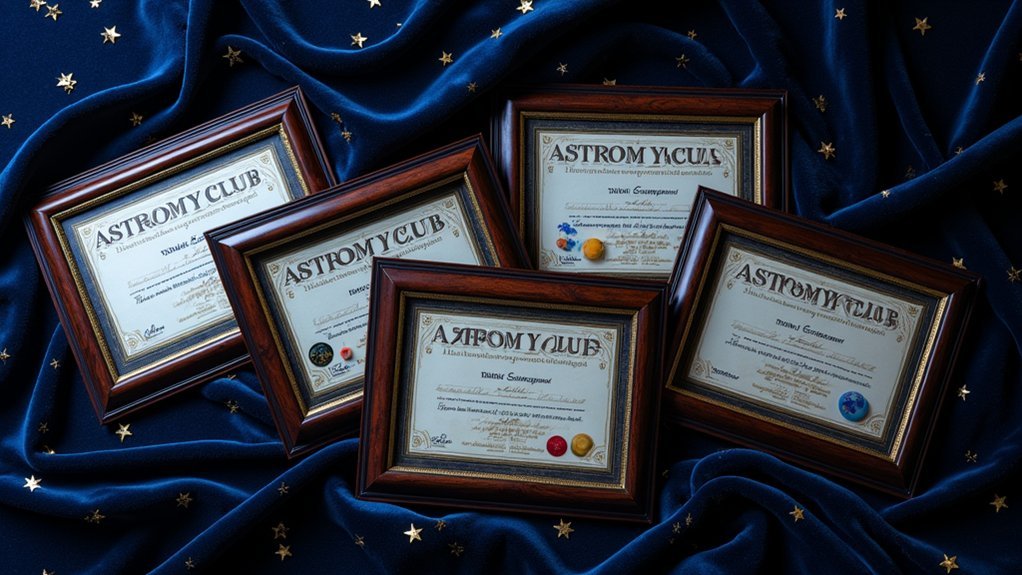You'll find that stargazing becomes more rewarding when you've got the right field guide by your side. Whether you're trying to spot Orion's Belt or identify that mysterious bright object in the night sky, these expert-recommended guides can transform your evening observations from confusion to clarity. From detailed star maps to mythology behind the constellations, let's explore the seven field guides that astronomy experts trust most for beginners.
Field Guide to the Night Sky (National Audubon Society Field Guides)
Whether you're taking your first steps into astronomy or seeking to deepen your stargazing experience, the National Audubon Society's Field Guide to the Night Sky stands out as an essential companion. The guide's user-friendly layout features detailed star maps, stunning illustrations, and rich mythology behind constellations.
You'll appreciate its compact size, perfect for nighttime excursions, and the seasonal maps help you plan observations throughout the year. While the guide excels in basics, be aware that some planetary data is outdated, and you might need additional resources for advanced topics. The print size could be larger for dark conditions, but the guide's beautiful visuals and accessible content make it a valuable starting point for exploring the cosmos.
Best For: Beginner to intermediate stargazers and amateur astronomers seeking a comprehensive, portable guide with beautiful illustrations and practical star maps for basic night sky observation.
Pros:
- Beautifully illustrated with detailed star maps and high-quality visuals
- Compact and portable design perfect for field use
- Well-organized content with seasonal maps and rich constellation mythology
Cons:
- Contains outdated planetary data and astronomical information
- Small print size can be difficult to read in low-light conditions
- Lacks depth for advanced astronomical topics and recent discoveries
Night Sky – A Field Guide to the Constellations
Looking to explore the wonders of the night sky? "Night Sky – A Field Guide to the Constellations" offers a perfect starting point for aspiring astronomers. This pocket-sized guide organizes constellations by season and difficulty, making it easy to navigate the celestial sphere.
You'll find valuable content including constellation mythology and practical tips for stargazing. While the included flashlight isn't particularly effective, the book's thorough approach helps you identify key features like the Milky Way and major star patterns. Keep in mind that the small font size might challenge readers with vision issues, but the guide's portability makes it ideal for field use.
Best For: Beginner and intermediate stargazers seeking a portable, season-organized guide to help identify constellations and learn about celestial objects during outdoor observation sessions.
Pros:
- Convenient pocket size makes it perfect for field use
- Well-organized content with constellations arranged by season and difficulty level
- Includes valuable educational content like constellation mythology and practical stargazing tips
Cons:
- Small font size may be difficult to read, especially in low light conditions
- Included flashlight is ineffective and poorly designed
- May be too basic for advanced astronomers seeking detailed scientific information
The Backyard Astronomer's Field Guide to Night Sky Objects
A spiral-bound field guide designed for both novice and experienced astronomers, David Dickinson's "Backyard Astronomer's Field Guide" stands out as a thorough resource for night sky exploration. You'll find monthly sky charts, highlights, and star lore for both hemispheres, along with an "Astrophysics 101" chapter that makes celestial concepts accessible.
While the guide's lay-flat design and vibrant charts enhance your stargazing experience, you might find its organization challenging. The separation of monthly sections from constellation tables can make locating specific objects difficult. Despite these drawbacks, you'll benefit from its practical insights, making it a valuable companion for your backyard astronomy adventures.
Best For: Amateur astronomers and families looking for a comprehensive, user-friendly guide to explore the night sky, with content suitable for both beginners and experienced stargazers.
Pros:
- Spiral-bound design allows the guide to lie flat during use
- Contains vibrant, easy-to-read charts for both Northern and Southern Hemispheres
- Includes clear explanations of astronomy concepts and monthly viewing highlights
Cons:
- Separation of monthly sections from constellation information makes navigation difficult
- Layout of constellation tables lacks organization and sufficient detail
- Cover material could be more durable for outdoor use
Field Guide to Meteors and Meteorites
The Field Guide to Meteors and Meteorites stands out as a scholarly resource that's particularly valuable for readers with a technical background in geology. You'll find extensive coverage of origins, types, and advanced identification techniques, complemented by high-quality color photos and detailed descriptions.
While it's not primarily aimed at beginners, you can use it alongside introductory texts like "Rocks from Space." The guide's unique chapters on optical mineralogy, historical discoveries, and modern space probe data make it essential for serious meteorite enthusiasts. Though the price and complexity reflect its advanced nature, you'll appreciate the thorough glossary and well-referenced chapters for deepening your understanding of these fascinating space rocks.
Best For: Technical readers and geology enthusiasts seeking comprehensive, scholarly information about meteors and meteorites.
Pros:
- Extensive technical detail and high-quality color photographs for accurate identification
- Well-referenced chapters with valuable appendices and glossary
- Comprehensive coverage of both historical discoveries and modern scientific data
Cons:
- Not beginner-friendly due to technical complexity
- Price point may be high for casual readers
- Physical format could be improved for field use (needs waterproofing and better binding)
The 100 Best Astrophotography Targets: Monthly Guide for Amateur Telescopes
Passionate stargazers seeking to capture the cosmos through their telescopes will find invaluable guidance in "The 100 Best Astrophotography Targets." While traditional observation guides focus on visual astronomy, this unique resource approaches celestial objects from an imager's perspective, featuring 109 carefully selected targets that are particularly photogenic.
You'll appreciate the book's practical organization, with targets arranged by their meridian appearance at 9 PM. Each entry provides essential background, capture techniques, and processing tips. Though published in 2009, the guide remains useful for beginners and intermediate imagers, offering guidance on scope usage and exposure times. Its portable format makes it perfect for imaging trips.
Best For: Amateur astrophotographers seeking a structured, month-by-month guide to photographing celestial objects, particularly those in the Northern Hemisphere looking to advance beyond basic imaging.
Pros:
- Well-organized monthly format makes it easy to plan imaging sessions based on optimal viewing times
- Includes practical information about capture techniques and processing tips for each target
- Features a curated selection of photogenic objects often overlooked in traditional observation guides
Cons:
- Some technical information and hardware references are outdated due to 2009 publication date
- Doesn't cover newer imaging techniques like narrowband imaging
- Not designed for outdoor use despite its portable size, making field reference more challenging
Turn Left At Orion: Night Sky Objects Guide for Home Telescopes
Widely regarded as astronomy's premier guidebook, "Turn Left at Orion" serves as an indispensable companion for both novice stargazers and intermediate astronomers who own small to medium-sized telescopes.
You'll find detailed views of over 100 celestial objects through multiple perspectives: naked eye, binoculars, and various telescope sizes up to 10 inches. The book's seasonal organization helps you navigate the night sky, while its realistic illustrations show exactly what you'll see through your equipment. Whether you're using an inexpensive refractor or a Dobsonian telescope, you'll appreciate the consistent vocabulary, clear instructions, and practical approach to celestial observation. Its user-friendly format makes complex astronomy accessible and enjoyable.
Best For: Amateur astronomers and beginners with small to medium-sized telescopes (up to 10 inches) who want a practical, easy-to-follow guide for identifying and observing night sky objects.
Pros:
- Comprehensive visual aids showing multiple perspectives (naked eye, binoculars, different telescope sizes) of over 100 celestial objects
- User-friendly organization with consistent vocabulary and clear instructions for locating objects
- Realistic illustrations that accurately represent what observers will actually see through their equipment
Cons:
- Seasonal organization may not be ideal for all users due to overlapping seasons
- Limited usefulness for owners of larger telescopes (14 inches or more)
- Requires supplementary reading for detailed equipment advice and additional visual references
Peterson First Guide To Insects Of North America
Beginners seeking an accessible introduction to insect identification will find Peterson First Guide To Insects Of North America particularly valuable, as it breaks down complex entomological concepts into manageable segments.
You'll discover 19 insect groups with detailed subgroupings, including 22 types of beetles. The guide's portable size makes it perfect for field exploration, while its clear explanations of life cycles, nomenclature, and insect anatomy provide essential foundational knowledge. Though the black and white illustrations aren't as impressive as other guides, they're adequate for basic identification.
While it's an excellent starting point for families and nature enthusiasts, you'll eventually need more thorough guides for advanced study.
Best For: Beginners, families, and casual nature enthusiasts seeking a basic, portable introduction to North American insects.
Pros:
- Portable size makes it convenient for outdoor exploration and field use
- Breaks down complex concepts into 19 manageable groups with clear subgroupings
- Excellent introduction to basic insect anatomy, life cycles, and nomenclature
Cons:
- Black and white illustrations are less impressive than other guides
- Limited content depth may frustrate more advanced users
- Insufficient for serious entomological study or detailed identification needs
Factors to Consider When Choosing Astronomy Field Guides for Novices
When you're selecting an astronomy field guide for your stargazing journey, you'll want to examine practical features like portability and physical design alongside the guide's content organization and visual clarity. You should verify the guide matches your current skill level while offering clear seasonal navigation tools to help you track celestial objects throughout the year. These key factors will shape how effectively you'll use the guide during your outdoor observations and ultimately determine its value as a learning resource.
Portability and Physical Design
Since stargazing often requires moving between different observation spots, choosing a field guide with ideal portability and physical design can make or break your astronomy experience.
Look for a compact guide that'll fit easily in your backpack or pocket, ensuring you won't leave it behind due to inconvenience. A spiral-bound format is particularly helpful, as it allows your guide to lie flat while you're consulting star charts during nighttime viewing sessions.
When examining potential guides, pay attention to the text size – you'll want print that's readable in dim conditions. While some guides include built-in flashlights, don't make this feature your primary consideration. Instead, focus on the guide's overall weight and dimensions. A lightweight design will prove invaluable during extended observation sessions when you're carrying multiple pieces of equipment.
Content Organization Methods
Beyond physical characteristics, the way a field guide organizes its content can greatly impact your learning journey. Look for guides that structure celestial objects by seasons, making it easier for you to spot what's actually visible during your observation time.
You'll want a guide that presents information in clear, distinct sections for constellations, planets, and celestial events. The best guides include progressive difficulty ratings, allowing you to start with simpler targets and advance as your skills improve. Check if the guide features detailed star maps and visual diagrams to help you navigate the night sky.
Don't overlook guides that weave in mythology and historical stories – these elements can make your stargazing experience more meaningful and help you remember celestial patterns more effectively.
Visual Clarity Features
Visual clarity stands at the forefront of any effective astronomy field guide. You'll want to look for guides featuring high-quality illustrations and photographs that accurately represent what you'll see through your equipment. The best guides use color-coded charts and vibrant designs to help you distinguish between different celestial objects effortlessly.
When selecting a guide, check that it offers user-friendly seasonal star maps with clear diagrams for easy navigation. Pay attention to the print size – larger fonts will help you read comfortably during nighttime viewing sessions. Look for helpful visual indicators, such as binocular icons and telescope-specific views, that show you exactly what to expect when observing various objects. These features will greatly improve your ability to identify and locate celestial bodies during your stargazing adventures.
Skill Level Appropriateness
Matching your astronomy guide to your skill level is essential for a rewarding stargazing experience. When you're just starting out, look for guides that offer straightforward explanations and basic observational methods designed specifically for beginners.
You'll want to find a guide that's organized by season and difficulty level, allowing you to build your celestial identification skills progressively. The best beginner guides feature clear, accessible language without complex astronomical jargon that might overwhelm new stargazers. Make sure your guide includes detailed illustrations and star maps that'll help you locate constellations and other night sky objects with confidence.
Don't forget to check if the guide provides additional resources for advanced learning. This way, you won't outgrow your guide as your astronomy knowledge expands.
Seasonal Navigation Tools
When selecting an astronomy field guide, seasonal navigation tools should be at the top of your checklist. You'll want a guide that provides star maps tailored to different times of the year, making it easier to identify constellations during specific seasons.
Look for guides that organize celestial objects by both difficulty level and seasonal visibility. This feature will help you build your stargazing skills systematically throughout the year. The best guides include monthly viewing highlights and detailed diagrams showing how stars and planets move across the night sky. You'll also benefit from practical information about seasonal phenomena like meteor showers, complete with ideal viewing times and locations. These tools guarantee you're looking in the right place at the right time, maximizing your chances of successful observations.
Current Information Accuracy
Current information accuracy stands as a critical factor in selecting your astronomy field guide, since outdated content can lead to frustrating observation sessions.
When evaluating guides, you'll want to check the publication date first – anything over five years old might not reflect recent astronomical discoveries or classification changes. Look for guides with up-to-date seasonal star maps, which are essential for accurately locating constellations throughout the year.
Make sure your chosen guide covers the latest advancements in observational technology and stargazing techniques. You'll also need current information about celestial objects, including planets and their moons, as new discoveries frequently emerge. While some guides offer basic details, others provide thorough coverage of celestial events. Choose one that matches your need for depth in astronomical data and findings.
Night Reading Practicality
A practical astronomy field guide should be easy to use during nighttime stargazing sessions. You'll want to check the print size carefully, as small text can be challenging to read in low light. Look for guides that come with built-in flashlights, though make sure to evaluate their effectiveness before purchasing.
Choose a guide that's organized logically by season or difficulty level, making it simpler to find information while you're outside. High-quality illustrations are essential – they'll help you identify celestial objects more accurately in dark conditions. The guide's size matters too; opt for a compact, portable design that fits in your pocket or backpack. This guarantees you can easily access your guide without interrupting your observation session.
Frequently Asked Questions
What Apps Can Complement My Astronomy Field Guide for Better Stargazing?
You'll enhance your stargazing with apps like Stellarium, Star Walk 2, and Sky Map. These help identify celestial objects, track constellations, and plan viewing sessions. NASA's app also provides real-time space news.
How Do I Protect My Field Guide From Dew During Nighttime Observations?
You'll need to keep your field guide dry by storing it in a clear plastic bag or waterproof sleeve. You can also use silica gel packets inside the bag for extra moisture protection during observations.
Should I Get a Digital or Physical Field Guide for Astronomy?
You'll want both formats for different situations. Physical guides work better under red light and don't need batteries, while digital guides offer quick searches and regular updates. Consider starting with physical, then adding digital later.
Can I Use Astronomy Field Guides in the Southern Hemisphere?
You'll need to check if your field guide covers the Southern Hemisphere, as many are designed for Northern skies. Look specifically for guides that include southern constellations and celestial objects visible from your location.
What Magnification of Binoculars Works Best With These Field Guides?
You'll get the best results with 7×50 or 10×50 binoculars. They're perfect for spotting objects listed in field guides, offering enough magnification to see details while still being stable in your hands.
In Summary
You'll find these seven field guides invaluable as you begin your stargazing journey. Whether you're tracking constellations, identifying meteors, or exploring deep-sky objects, these expert-recommended resources offer the perfect blend of practical knowledge and visual aids. Don't forget to reflect on your specific needs when selecting a guide, and you'll soon be traversing the night sky with confidence and understanding.





Leave a Reply